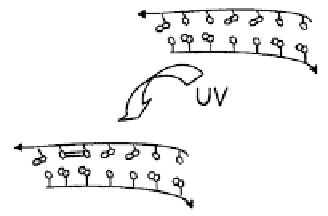Environmental Engineering Reference
In-Depth Information
GENETIC AND MOLECULAR ANALYSIS OF DNA DAMAGE REPAIR AND
TOLERANCE PATHWAYS
B. M. SUTHERLAND
Brookhaven National Laboratory,
Upton, NY, 11973, USA
1. Introduction
Radiation can damage cellular components, including DNA. Organisms have developed
a panoply of means of dealing with DNA damage. Some repair paths have rather narrow
substrate specificity (e.g. photolyases, which act on specific pyrimidine photoproducts
in a specific type (e.g., DNA) and conformation (double-stranded B conformation) of
nucleic acid. Others, for example, nucleotide excision repair, deal with larger classes of
damages, in this case bulky adducts in DNA.
A detailed discussion of DNA repair mechanisms is beyond the scope of this
article, but one can be found in the excellent topic of Friedberg et al. [1] for further
detail. However, some DNA damages and paths for repair of those damages important
for photobiology will be outlined below as a basis for the specific examples of genetic
and molecular analysis that will be presented below.
2. DNA Damages
The major photoproduct formed in DNA by UV radiation is the cyclobutyl pyrimidine
dimer (CPD); although [6-4] pyrimidine-pyrimidone adducts are induced at lower level,
they are also significant in production of biological damage. Other pyrimidine
photoproducts (e.g., hydrates) are formed by UV, but purine photoproducts are induced
only at much lower levels.
Figure 1. Induction of cyclobutyl pyrimidine dimer in DNA by UV radiation.
In addition to DNA damages formed by UV, all organisms living in an oxygen
environment suffer from oxidative damage to DNA. They also carry out replication

Search WWH ::

Custom Search